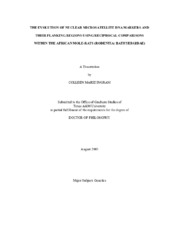The evolution of nuclear microsatellite DNA markers and their flanking regions using reciprocal comparisons within the African mole-rats (Rodentia: Bathyergidae)
Abstract
Microsatellites are repetitive DNA characterized by tandem repeats of short
motifs (2 – 5 bp). High mutation rates make them ideal for population level studies.
Microsatellite allele genesis is generally attributed to strand slippage, and it is assumed
that alleles are caused only by changes in repeat number. Most analyses are limited to
alleles (electromorphs) scored by mobility only, and models of evolution rarely account
for homoplasy in allele length. Additionally, insertion/deletion events (indels) in the
flanking region or interruptions in the repeat can obfuscate the accuracy of genotyping.
Many investigators use microsatellites, designed for a focal species, to screen for
genetic variation in non-focal species. Comparative studies have shown different
mutation rates of microsatellites in different species, and even individuals. Recent
studies have used reciprocal comparisons to assess the level of polymorphism of
microsatellites between pairs of taxa.
In this study, I investigated the evolution of microsatellites within a phylogenetic
context, using comparisons within the rodent family Bathyergidae. Bathyergidae
represents a monophyletic group endemic to sub-Saharan Africa and relationships are well supported by morphological and molecular data. Using mitochondrial and nuclear
DNA, a robust phylogeny was generated for the Bathyergidae. From my results, I
proposed the new genus, Coetomys.
I designed species-specific genotyping and microsatellite flanking sequence
(MFS) primers for each genus. Sequencing of the MFS provided direct evidence of the
evolutionary dynamics of the repeat motifs and their flanking sequence, including
rampant electromorphic homoplasy, null alleles, and indels. This adds to the growing
body of evidence regarding problems with genotype scores from fragment analysis. A
number of the loci isolated were linked with repetitive elements (LTRs and SINEs),
characterized as robust phylogenetic characters. Results suggest that cryptic variation in
microsatellite loci are not trivial and should be assessed in all studies.
The phylogenetic utility of the nucleotide variation of the MFS was compared to
the well-resolved relationships of this family based on the 12S/TTR phylogeny.
Variation observed in MFS generated robust phylogenies, congruent with results from
12S/TTR. Finally, a number of the indels within the MFS provided a suite of suitable
phylogenetic characters.
Subject
Microsatellite DNAMolecular Evolution
Microsatellite Flanking Sequences
MFS
Ascertainment Bias
Null Alleles
Electromorphic Homoplasy
Microsatellite Indels
Phylogenetics
Fragment Analysis
Africa
Mole-Rats
Bathyergidae
Rodentia
Coetomys
Cryptomys
Bathyergus
Georychus
Heliophobius
Heterocephalus
Mammalia
Citation
Ingram, Colleen Marie (2005). The evolution of nuclear microsatellite DNA markers and their flanking regions using reciprocal comparisons within the African mole-rats (Rodentia: Bathyergidae). Doctoral dissertation, Texas A&M University. Texas A&M University. Available electronically from https : / /hdl .handle .net /1969 .1 /4370.


